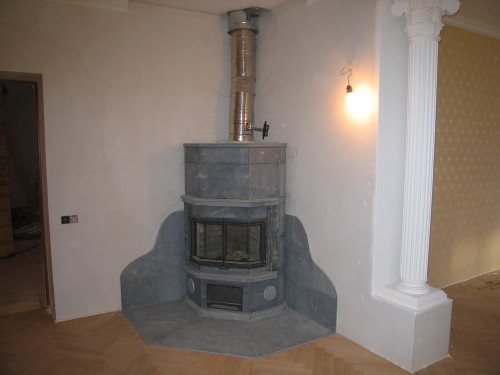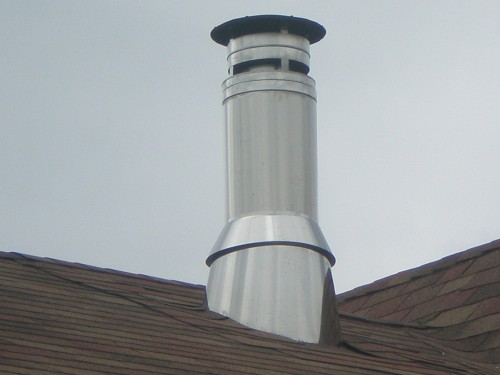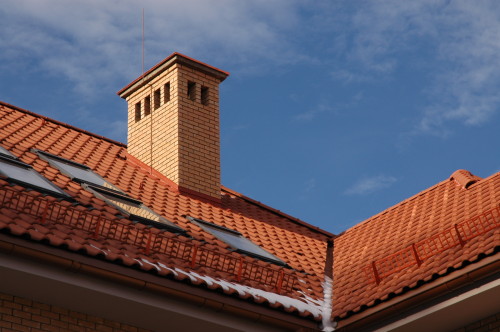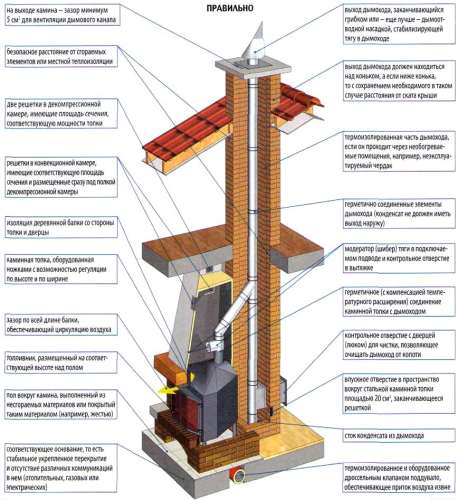
Firewood Chimney: Installation Instructions Construction
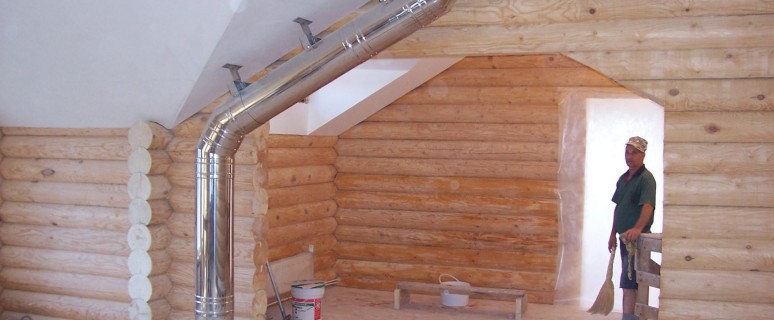
Almost every private house, as well as a country structure, has a fireplace that is capable not only to decorate the inner space of the room, but also to significantly increase comfort. Indeed, the fireplace allows you to forget about such an unpleasant coolness in the winter period, which is disturbing even if there are heating systems in the house. In any case, you can conveniently sit near the fireplace and feel pleasant warmth.
Content
However, it is not necessary to think that the fireplace is an attribute of exclusively solid houses, the owners of which can spend huge money for various buildings. Fireplace and chimney can be created without any problems with their own hands, for this you also do not need a lot of experience. The most important thing is to follow the detailed instructions that will not allow to allow common errors.
In this material we will try to consider all issues related to the installation of chimney for the fireplace. This process includes several important stages that we will try to analyze.
Also in the article you can find a lot of interesting information, which is unambiguously useful and during the construction of the chimney, and during the operation of the fireplace.
Main features of the erection of chimney
Most often, fireplaces are installed in large private houses, where there is enough space to install a massive design. Creating a high-quality chimney is an essential aspect that allows you to operate the fireplace without any problems for long years.
If the chimney is erected with some errors, then smoke can start accumulate directly into the dwelling, which cannot be allowed. Moreover, a scenario is quite likely, in which a huge amount of soot and tar will accumulate in the chimney.
The main thing is to remember that the chimney should contribute to the strength of thrust. This factor depends on the design of the fireplace, and on the specifics of the erection of the chimney.
With regard to the basic chimney requirements, they are as follows:
- Minimum amount of bends. Experts believe the chimney should not have more than three bends. Moreover, the bends themselves should not have too large tilt angles. Thus, experts advise to do so that the angle of bends does not exceed 45 degrees. If we have several big tilt angles, the efficiency of the chimney is rapidly falling.
- Minimum number of horizontal sections. There are also serious requirements here. It is best when there are no horizontal sites, as they can significantly worsen the craving, in some cases - several times.
- The height of the chimney is about 5 m. Only with this situation we will receive an excellent traction that allows you to exploit the fireplace for long years and forget about problems. A large height of the chimney is allowed, but if this value is less than 5 m, then the problems are unlikely to be avoided.
- The chimney cross section should be no less than the cross section of the fireplace. In this case, we are talking about the efficiency of the heat source.
In addition, it is often for the quality of the thrust affects the smoothness of the chimney. With the proper approach, even a narrow, but smooth chimney provides excellent traction. These are quite specific questions that need to be considered and analyzed by specialists. A detailed calculation of the design is performed, after which the appropriate solutions are accepted.
It is also necessary to pay attention to the fact that the most important part of the fireplace is a revision. This component is located at the bottom of the chimney. The main function of the revision is to use when cleaning the chimney from combustion products. Accordingly, this is the most important point on which the efficiency of the fireplace depends.
The shortcomings of the chimney pipe based on bricks
It should be borne in mind that the chimneys have their essential flaws that a few words should be said about. First of all it refers to brick chimney. Their service life is quite limited. Specialists argue that chimneys from bricks can be operated within ten years. Next, still have to replace. This trouble is related to the fact that in the winter period, the brick freezes and thaws, respectively, the material gradually collapses and over time becomes a serious threat.
Thus, if possible, it should be abandoned from the use of bricks, since the remaining materials used by creating a chimney for the fireplace have much more advantages.
However, some weaknesses of the brick chimney can be taken into account and somewhat reduce the negative impact of weather conditions. For example, you can increase the cross section of the outer walls of the chimney. It should be limited to the site that opposes the roof. In addition, insulation can be carried out, which will significantly improve the situation with the durability of bricks.
Many specialists are not recommended to build a chimney of bricks also for the reason that such a design has a lot of irregularities, as well as roughness inside. This trouble refers directly to not the highest value of the traction efficiency. However, in this case there are some interesting subtleties. Inside the brick chimney, you can install a metal tube that does not have the most unpleasant flaws.
Basic materials for chimneys
Brick is just one of many materials used for the construction of the chimney. It should be noted that today it is not so fundamentally to use some particular material, so the selection depends solely on the preferences of the owners.
- Steel chimney. Such a chimney has many advantages. First of all, these are the ease of installation, a small weight, as well as the lack of the need for the creation of an additional base (foundation) for such a design. Many may not really like the appearance of such a chimney, but it can be easily hidden behind the brickwork.
- Glass. This is really an excellent option to create a chimney. The glass does not absorb moisture, is not amenable to the action of corrosion, as well as other influences. However, it is worth understanding that this option for the construction of the chimney is significantly more expensive than the rest of the products, so it is used somewhat less often.
- Ceramics. As is known, the refractory ceramics has many advantages. Specialists active compared with steel chimney variant embodiment, since the advantages and disadvantages about the same. However, it must be said that the ceramic has a much more pleasing appearance.
It is worth noting that you can use any of the submissions without any problems. The only thing you need to pay attention - this is the price issue, as sometimes chimneys can be very expensive.
The main stages of the chimney installation
chimney calculations
First performed detailed calculations of the chimney. Already at this stage we need to determine the materials needed to create the chimney. For calculations using a simple piece of paper, a pencil and a ruler. Create a simple sketch that will help you understand the structure of the future of the chimney. You need to pay attention to the following requirements:
- The diameter of the chimney must not only be less than the diameter of the outlet. In addition, a similar situation and with the diameter of the nozzle of the fire.
- To determine the optimum diameter of the chimney must apply to the state standards, which specify the most appropriate section for specific conditions. Particular attention should be paid to GOST 9817-95.
It also makes sense to analyze the created sketch together with experts. Most often in these matters oriented companies that supply resources to build fireplaces and chimneys. In addition, if you are not sure whether the future chimney designed properly, you can look for ready-made options on the Internet.
installation of chimney
At this stage, the most important stage of work. To begin with, as we have said, it is necessary to determine the diameter of the chimney.
In this case, everything must be done to the chimney without any problems was through the roof.
Particular attention should be paid to the installation of chimneys in wooden buildings. For wood roof, the chimney can be a serious problem, because of which a fire or slight inflammation begins. In this case, you need to use transient connections, which will save from all these problems and provide better insulation between the roof and the chimney. Of course, the outlet must have a slightly larger diameter than the chimney itself, but the insulating element is to be mounted tightly as possible.
At the same time, if we create a hole in the roof, you need to pay much attention to its diameter. The most important thing is that this hole is a little more than the chimney itself, with this any problem areas can be easily hidden.
If there are significant gaps, you can freely use insulating material. For example, it can be mineral wool. The main thing is that the insulation tightly entered into the resulting gap. In addition, foil isolation is often used, which successfully reflects the rays of light.
Again, it should be focused on the fact that there were no joints in the field of the created chimney. This not only reduces the efficiency of the fireplace, but also significantly worsens the security conditions. In the same way, the durability of the created design is also falling.
Specialists advise to do everything possible so that the chimney is solid, since often the hosts use for these purposes and part of the overlap, and many other housing elements through which the pipe passes. But with this situation, you can encounter many problem areas. In addition, in this case it is impossible to be confident that there are no gaps in such a chimney that create many dangerous situations.
Separately, it is necessary to say about the chimney mounting, if the pipe itself will go through several residential rooms. In this case, the pipe must be covered with a protective casing together with ventilation grids, which cancel heat from the chimney.
Mounting through the roof
The most difficult and responsible stage of work is the installation of chimney through the roof. Here we need to pay a lot of attention to the safety and quality of installation.
A serious danger may wait for the owners of the dwelling in the event that we have a roof of flammable materials. This means that the trimmed chimney can cause a fire, to quickly stop which will be almost impossible.
In addition, it will require elements of sealing, which protect the roof from the fallout. There are a lot of options for such products on sale, however, the inclination of the roof and the shape of the material should be paid.
Most often on sale you can find sealing with a slope of 15-35 °, as well as 35-55 °. If the material under the desired angle is not on sale, you should contact consultants in a construction store and ask all the questions you are interested in. It should be borne in mind that any problem can be solved, however, for individual construction activities it is better to use the services of specialists.
Sealing, which is often called cutting, should be a little to enter the main surface of the roof. In this case, this material completely covers all the gaps present on the roof.
Separately, it should be said that when creating a brick chimney, there are practically no problems, since the masonry will never warm very much, unlike the same metal pipe. Also, an adjustable apron is often used to increase tightness.
Well, in conclusion, I would like to say that in such conditions, the owners also install special umbrellas on the roofs, which do not allow precipitation to get inside the housing. Of course, it is only an additional safety measure, however, it has tremendous importance. To begin with, it is worth checking the main sealing, which should be flawless. Before reaching the excellent installation quality, the fireplace cannot be operated.




